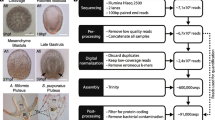Abstract
Available data on the formation of echinoderm skeleton are reviewed based on the literature. The development and structural features of the skeleton and morphological, histological, and molecular data on the skeleton formation in different echinoderm groups are described. Recent data on the study of gene regulatory networks and their effect on biomineraization and skeleton formation are also included. The skeletogenic mechanisms are in general highly conservative within echinoderms at the levels of genes, gene regulatory networks, and involved cell populations. At the same time, the formation mechanism of the echinoderm skeleton is unique and has not been recorded in other taxonomic groups.
Similar content being viewed by others
References
Ameye, L., Compère, P., Dille, J., and Dubois, P., Ultrastructure and cytochemistry of the early calcification site and of its mineralization organic matrix in Paracentrotus lividus (Echinodermata: Echinoidea), Histochem. Cell Biol., 1998, vol. 110, pp. 285–294.
Ameye, L., De Becker, G., Killian, C., et al., Proteins and saccharides of the sea urchin organic matrix of mineralization: Characterization and localization in the spine skeleton, J. Struct. Biol., 2001, vol. 134, pp. 56–66.
Ausich, W.I. and Baumiller, T.K., Taphonomic method for determining muscular articulations in fossil crinoids, Palaios, 1993, vol. 8, no. 5, pp. 477–484.
Bennett, K.C., Young, C.M., and Emlet, R.B., Larval development and metamorphosis of the deep-sea cidaroid urchin Cidaris blakei, Biol. Bull., 2012, vol. 222, no. 2, pp. 105–117.
Bottjer, D.J., Davidson, E.H., Peterson, K.J., and Cameron, R.A., Paleogenomics of echinoderms, Science, 2006, vol. 314, no. 5801, pp. 956–960.
Clausen, S. and Smith, A.B., Palaeoanatomy and biological affinities of a Cambrian deuterostome (Stylophora), Nature, 2005, vol. 438, no. 7066, pp. 351–354.
Donovan, S.K., The improbability of a muscular crinoid column, Lethaia, 1989, vol. 22, no. 3, pp. 307–315.
Ettensohn, C.A., Lessons from a gene regulatory network: Echinoderm skeletogenesis provides insights into evolution, plasticity and morphogenesis, Development, 2009, vol. 136, no. 1, pp. 11–21.
Ettensohn, C.A., Kitazawa, C., Cheers, M.S., et al., Gene regulatory networks and developmental plasticity in the early sea urchin embryo: Alternative deployment of the skeletogenic gene regulatory network, Development, 2007, vol. 134, no. 17, pp. 3077–3087.
Fedotov, D.M., The Phylum Echinodermata, in Rukovodstvo po zoologii (Handbook on Zoology), Moscow: Sovet. Nauka, 1951, vol. 3, part 2, pp. 460–591.
Gage, J.D., Skeletal growth markers in the deep-sea brittle stars Ophiura ljungmani and Ophiomusium lymani, Marine Biol., 1990, vol. 104, no. 3, pp. 427–435.
Gao, F. and Davidson, E.H., Transfer of a large gene regulatory apparatus to a new developmental address in echinoid evolution, Proc. Nat. Acad. Sci., 2008, vol. 105, no. 16, pp. 6091–6096.
Gilbert, P.U.P.A. and Wilt, F.H., Molecular aspects of biomineralization of the echinoderm endoskeleton, in Molecular Biomineralization, Berlin-Heidelberg: Springer, 2011, pp. 199–223.
Gliznutsa, L.A. and Dautov, S.Sh., Cell differentiation during the larval development of the ophiuroid Amphipholis kochii Lutken, 1872 (Echinodermata: Ophiuroidea), Rus. J. Marine Biol., 2011, vol. 37, no. 5, pp. 384–400.
Hinman, V.F., Nguyen, A.T., Cameron, R.A., and Davidson, E.H., Developmental gene regulatory network architecture across 500 million years of echinoderm evolution, Proc. Nat. Acad. Sci., 2003, vol. 100, no. 23, pp. 13356–13361.
Jefferies, R.P.S., The Ancestry of the Vertebrates, London: Brit. Mus. Natur. Hist., 1986.
Lapham, K.E., Ausich, W.I., and Lane, N.G., A technique for developing the stereom of fossil crinoid ossicles, J. Paleontol., 1976, vol. 2, no. 50, pp. 245–248.
Märkel, K., Röser, U., Mackenstedt, U., and Klostermann, M., Ultrastructural investigation of matrixmediated biomineralization in echinoids (Echinodermata, Echinoida), Zoomorphology, 1986, vol. 106, no. 4, pp. 232–243.
Nakano, E., Okazaki, K., and Iwamatsu, T., Accumulation of radioactive calcium in larvae of the sea urchin Pseudocentrotus depressus, Biol. Bull., 1963, vol. 125, pp. 125–132.
Okazaki, K., Skeleton formation of sea urchin larvae: 1. Effect of Ca concentration of the medium, Biol. Bull., 1956, vol. 110, no. 3, pp. 320–333.
Okazaki, K., Spicule formation by isolated micromeres of the sea urchin embryo, Am. Zool., 1975, vol. 15, no. 3, pp. 567–581.
Raz, S., Hamilton, P.C., Wilt, F.H., et al., The transient phase of amorphous calcium carbonate in sea urchin larval spicules: The involvement of proteins and magnesium ions in its formation and stabilization, Adv. Funct. Mater., 2003, vol. 13, no. 6, pp. 480–486.
Roux, M., Microstructural analysis of the crinoid stem, Univ. Kansas Paleontol. Contrib., 1975, vol. 75, pp. 1–7.
Sevastopulo, G.D. and Keegan, J.B., A technique for revealing the stereom structure of fossil crinoids, Palaeontology, 1980, vol. 23, no. 4, pp. 749–756.
Smith, A.B., The structure and arrangement of echinoid tubercles, Phil. Trans. R. Soc. London, Ser. B Biol. Sci., 1980, vol. 289, no. 1033, pp. 1–54.
Vinnikova, V.V. and Drozdov, A.,L., Ultrastructure of spines in regular sea urchins of the family Strongylocentrotidae, Zool. Zh., 2011, vol. 90, no. 5, pp. 573–579.
Wilt, F.H., Matrix and mineral in the sea urchin larval skeleton, J. Struct. Biol., 1999, vol. 126, no. 3, pp. 216–226.
Wilt, F.H., Killian, C.E., Hamilton, P., and Croker, L., The dynamics of secretion during sea urchin embryonic skeleton formation, Exp. Cell Res., 2008, vol. 314, pp. 1744–1752.
Wray, G.A. and McClay, D.R., The origin of spicule-forming cells in a’ primitive’ sea urchin (Eucidaris tribuloides) which appears to lack primary mesenchyme cells, Development, 1988, vol. 103, no. 2, pp. 305–315.
Yajima, M., A switch in the cellular basis of skeletogenesis in late-stage sea urchin larvae, Dev. Biol., 2007, vol. 307, no. 2, pp. 272–281.
Yajima, M. and Kiyomoto, M., Study of larval and adult skeletogenic cells in developing sea urchin larvae, Biol. Bull., 2006, vol. 211, no. 2, pp. 183–192.
Author information
Authors and Affiliations
Corresponding author
Rights and permissions
About this article
Cite this article
Kokorin, A.I., Mirantsev, G.V. & Rozhnov, S.V. General features of echinoderm skeleton formation. Paleontol. J. 48, 1532–1539 (2014). https://doi.org/10.1134/S0031030114140056
Received:
Published:
Issue Date:
DOI: https://doi.org/10.1134/S0031030114140056




